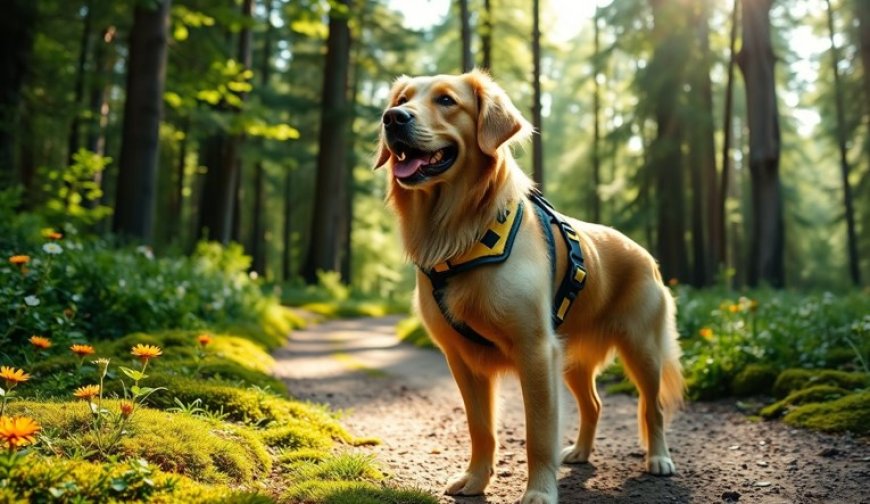Dog Harnesses: Ensuring Safety, Comfort, and Control for Your Pet
Dogs are more than just pets; they are family members. As such, their safety and comfort during walks are essential.

Dogs are more than just pets; they are family members. As such, their safety and comfort during walks are essential. Dog harnesses have become more popular than traditional collars, thanks to their many advantages. They help prevent injuries, improve control, and make walks more enjoyable. Picking the right harness depends on your dogs breed, size, and activity level. This guide walks you through everything you need to know about dog harnessesfrom types to fitting, and how to keep them in top shape.
Understanding Why Dog Harnesses Are Essential
The Health Benefits of Using a Harness
A well-chosen harness can protect your dog from injuries. Unlike collars that put pressure on the neck, harnesses spread force evenly across the chest and shoulders. This distribution prevents neck injuries and choking hazardsespecially in small or delicate breeds. Studies show that dogs using harnesses suffer fewer trachea damage and neck issues. Its a simple step that keeps your pup healthier on every walk.
Safety and Control During Walks
Harnesses give pet owners better control over their dogs during walks. If your dog pulls or reacts to sights and sounds, a harness helps manage that behavior. For older dogs or those with health problems, harnesses reduce strain on joints and bones. Veterinarians often recommend harnesses for safer, more controlled walks. They help prevent accidents and give your dog a secure feeling while exploring.
Suitable for Different Dog Breeds and Sizes
Size and breed are key when choosing a harness. Small dogs like Chihuahuas or Yorkies need snug, comfortable harnesses. Sighthounds, like Greyhounds, have unique body shapes that require specialty harnesses. Larger breeds, such as Labs or Shepherds, need durable options that can handle strength and movement. Picking the right harness ensures your dog stays safe and comfortable.
Types of Dog Harnesses and Their Features
Front-Clip Harnesses
Front-clip harnesses attach the leash at the front of the dogs chest. They give owners better control and are excellent for teaching dogs to walk without pulling. They also reduce pulling behavior in reactive dogs. Look for features like adjustable straps and padding for comfort. They're ideal for training, especially with breeds that tend to pull or be reactive.
Back-Clip Harnesses
These harnesses connect at the back and are super easy to put on. They work well for casual walks or dogs that dont pull much. However, they might not be the best choice for dogs that tend to pull hard, as they can encourage pulling instead of discouraging it. Their simplicity makes them popular for everyday use and for small or calm dogs.
Overhead and Step-In Harnesses
Overhead harnesses go over a dogs head, making them easy to slip on. Step-in harnesses require the dog to stand inside the straps before buckling up. Both types are comfortable and hassle-free, perfect for puppies or older dogs with mobility issues. Theyre gentle options for dogs new to harness-wearing.
Specialty Harnesses
- No-pull harnesses: Designed to discourage pulling by redirecting your dogs forward motion.
- Escape-proof harnesses: Built with extra security for escape artists that love to wiggle out.
- Reflective and light-up harnesses: Increase visibility during night walks for safety.
Factors to Consider When Choosing a Dog Harness
Proper Fit and Sizing
Getting the right size is vital. Measure around your dogs chest, behind the front legs, and around the neck. Adjustable straps allow for growth and comfort as your pup matures. Avoid harnesses that are too tightthey can chafe or restrict movement. Similarly, loose fitting harnesses might slip off. Proper fitting means no chafing, pinching, or slipping.
Material and Durability
Look for sturdy yet comfy materials like nylon, leather, or breathable mesh. Weather-resistant options help keep your dog comfortable all year round. For outdoor adventures, waterproof or quick-drying harnesses are best. Investing in a quality harness means it will last through rough walks and multiple seasons.
Safety Features
Safety comes first. Check the buckle strengthcheap clips can break easily. Impact-absorbing padding reduces pressure points. Reflective strips enhance night-time visibility. These features make sure your dog is safe during every step outside.
Ease of Use and Convenience
Choose harnesses with quick-release buckles for fast grooming and adjustments. They should be simple to put on and take off, especially if youre often in a rush. Compatibility with leash attachments is also important. Some harnesses offer multiple leash points for different control options.
Training Tips for Using a Dog Harness Effectively
Introducing the Harness to Your Dog
Start slowly. Let your dog sniff and explore the harness before putting it on. Use treats and praise to create positive associations. Gradually increase wearing time, starting with short sessions.
Teaching Proper Walk Behavior
Harnesses are tools to help with training. Use commands like heel or leave it to manage pulling. Reward your dog when they walk calmly beside you. Consistent training turns harness control into good walking habits.
Troubleshooting Common Issues
Some dogs may try to wiggle out or feel uncomfortable. Adjust the fit as needed. If your dog chafes or gets annoyed, try a different style or padding. Regularly check for and fix any wear and tear to keep your pet safe.
Maintenance and Care of Dog Harnesses
Cleaning Procedures
Wash harnesses according to their material. Nylon and mesh can usually be machine-washed on gentle. Leather harnesses need hand cleaning with a damp cloth. Clean the harness regularly, about once a month, or more if your dog gets particularly muddy or sweaty.
Inspection and Replacement
Look for frayed straps, damaged buckles, or worn-out padding. A compromised harness can break and cause safety issues. Replace the harness immediately if it shows signs of excessive wear or damage.
Storage Tips
Keep harnesses in a dry, cool place away from direct sunlight. Proper storage prevents cracking, fading, and warping. When not in use, hang or fold the harness neatly to sustain its shape and quality.
Choosing the right dog harness is crucial for your pets health and safety. A good fit, durable materials, and safety features make walks more enjoyable and less stressful. Remember, a harness isnt just about control; its about keeping your dog secure and comfortable. Regularly review and adjust the harness as your dog grows or changes. With the right choice and proper training, your walks can become some of the best moments you share with your furry friend.










































